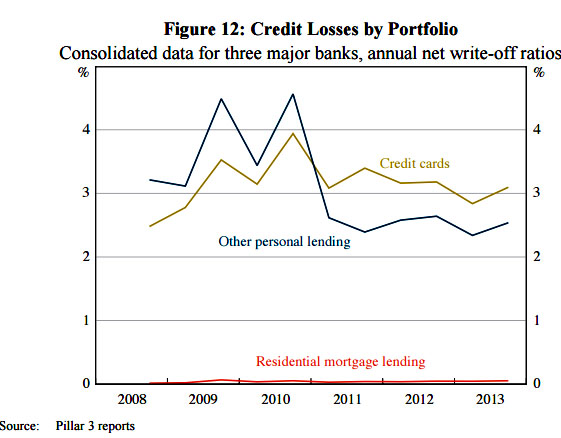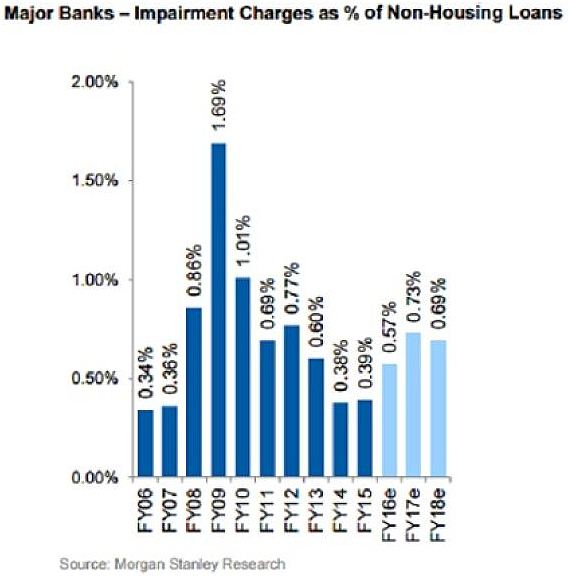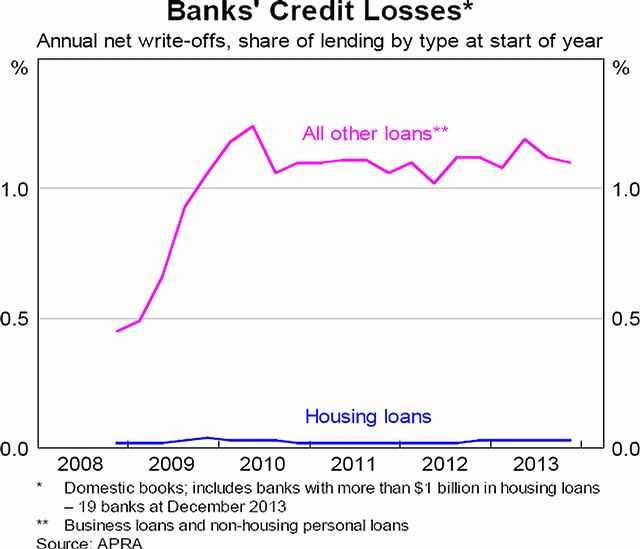|
| |
Grounds/Reasons for
the Written Questions
Chapter
10. The CEO's of the Four Pillars were questioned by a
House of Representatives Standing Committee on Economics
in Oct 2016
Three
CEO's, and likely several Senate Committee members, are unaware of the Reserve Bank's
above noted
'extensive powers' to gather information from a
payment system or from individual participants
CEOs would like you to believe that Credit Card Products have very high
bad debt write-offs, but do they? What annual write-off amount is high for
a Pillar Bank?
Below are extracts
from SMH reports of
questions asked of some of the four CEO's by the
House of Representatives Standing Committee on Economics - Review of Australia's
Four Major Banks in
Oct 2016:
LNP's Scott
Buchholz asked how much revenue Westpac's credit card business
generates.
"Where would you
allocate the profit to?"
"We don't have a credit card business,"
Westpac's CEO, Mr Hartzer responded that credit
cards fell within multiple business units.
After a brief
circular exchange Committee Chair David Coleman intervened by asking Mr Hartzer
to confirm he wasn't answering the question.
"What I'm saying is
that we're not able to
answer that question because we don't have a credit card business per se,"
Mr Hartzer said.
David Coleman
noted the Committee might be in-touch about this issue.
Labor’s
Matt Keogh is curious about the profitability of credit cards and asked ANZ
CEO , Shane
Elliot, who responded:
“I’m not sure that we disclose that,
but I’ll give you a rough idea. It would be, after tax, a couple of hundred
million dollars,”
Elliott acknowledged that it is a large amount of money,
albeit a small share of the banks’ overall earnings.
The Australian - 6 Oct 2016 reported that Commonwealth Bank's chief
executive, Ian Narev, resisted providing returns across products, claiming
these are commercially sensitive for competitive reasons.
A
CEO commented that the Credit Card Product has
"high risk debt" and did not encourage customers "to take on high amounts of
high-risk debt":
"Commonwealth Bank boss, Ian Narev, has defended the
bank’s exorbitant credit card interest rates, insisting it’s high-risk debt, AAP writes.
Mr. Narev was grilled today over credit card rates. He was asked why the cash advance rate on the
bank’s low rate card was more than 21 per cent, when the official cash rate is
just 1.5 per cent. “To me, that’s gouging, that’s excessive,” coalition
backbencher Scott Buchholz said. “It is a highly profitable part of the business,
how is that fair?”
Mr. Narev said he understood the concerns, but
argued the bank did not encourage its customers to take on high amounts of
high-risk debt.
“I said we came in here with a spirit of openness
and listen to suggestions and we will,” Mr. Narev replied."
CBA CEO, Ian Narev, deflected questions on the profitability of Credit Cards:
*
"We don’t disclose the returns on equity by individual products,” he said in
response to questioning from Labor MP Pat Conroy.
*
“In highly competitive markets, you don’t want these individual aspects of
product profitability disclosed to your competitors.”
Below are extracts
from SMH reports of
questions asked of some of the four CEO's by the
House of Representatives Standing Committee on Economics - Review of Australia's
Four Major Banks in
Oct 2016 which provides a 'ball park' brake-up of the Credit Card business by
the ANZ CEO,
Shane Elliot:
Shane Elliot has given Liberal MP Scott Buchholz an
illustrative breakdown of costs in the credit cards business (re
the pie chart on RHS "Costs" in
Chapter 8 above):
"If the credit card
section were a stand-alone business, he says -
*
25 per cent of the cost would be the cost of funds.
*
another quarter would be features - insurance, reward points etc
*
while about a third are the administrative systems needed.
*
the balance, slightly less than 20 per cent, is lost through bad debts and
fraud."
ANZ CEO, Shane Elliot, responded to a question about
the profitability of credit cards,
“I’m not sure that we disclose that, but I’ll give you a rough idea. It would
be, after tax, a couple of hundred million dollars,”
Elliott says, acknowledging it is a large amount of money
albeit a small share of the banks’ overall earnings.
ANZ
to consider slicing credit card rates: ANZ Banking Group will consider
cutting interest rates on its credit cards and introducing a pricing regime
based on "borrower risk".
Shane Elliott, CEO ANZ said:
The bank is currently looking at
changing the parameters for credit cards to ensure people can avoid
financial hardship.
“It’s the right thing for us as well ... It’s not in our
interest to have customers with products they can’t service,”
he says.
Pressed by Liberal MP Scott Buchholz whether there was
“ample opportunity”
for card rates to be lower, Mr. Elliott said:
“As a general proposition, I think you’re right.”
“I think there’s an opportunity for us frankly
to take a bit of leadership on this and do something better on not just the
interest rate but also the fee structure on cards,”
Shane Elliott said.
He also said ANZ would look to
harness big data to discover low-risk customers that could be offered lower
interest rates.
Andrew Thorburn, CEO NAB said
"The credit
card business has some of the 'highest losses in our portfolio' and one third of
their customers were on a 13.99 per cent 'low rate' card."
The
Four Pillars
bad debt
write-off rates would be lower and discourage
"its customers to take on high amounts of high-risk debt", if
all Credit Card Issuers in
Australia were regulated to -
A) limit school leavers
from 18 years
to a
Charge Card for the initial six months,
thereby necessitating the
Total Amount Owing
to be repaid at the end of each monthly cycle, in order to establish/improve their
Credit Rating;
B) then
(after six months of repaying the
Total Amount Owing
each month in arrears)
replace their
Charge Card
with a Credit Card
with a prudent
Card Limit which could be increased no more than once a year according to the
Credit Cardholders'
Credit Rating;
and
C) require all
Credit Cardholders to pay a minimum of
25% of the
Total Amount Owing
each month,
whereby
Cardholders could contact their
Credit Card Issuer and request their Credit Card Issuer to reduce the monthly
limit to 5% for up to two years dependant upon the normal parameters governing
an
Unsecured Personal Loan
application.
Re C) above,
McKinsey Report -
May 2014 categorizes 'Five Segments' of Credit Cardholders in the USA.
Below is an extract from the 'Third Segment' of
USA Credit Cardholders,
namely 'Financially
stressed' Credit Cardholders:
"Value simplicity and transparency in fees, rates and terms, but their
biggest need is for something that NO credit card offers: a mechanism
allowing them to impose their own spending limits which would enable them to
carry a credit card for larger purchases that take time to pay off, without
fearing they might be tempted to use it for non-essentials."
The
below three graphs seek to identify write-offs on Credit Cards by the major
Australian Credit Card Issuers.
|

The above graph from
Reserve Bank's
Credit
Losses at Australian Banks: 1980–2013 shows annual net write-offs for
Credit Cards for three of the Four Pillars
in 2013 was 3.1% of Debt Outstanding.
The above RBA graph seems to infer that
for every $100 funded by a Credit Card Issuer to a Credit Cardholder, the Credit
Card Issuer will not get $3.10 back in 2013. But are Credit Card Issuers
making 17% on ave. before costs on the remaining 96.9% Credit Cardholders?
|
|

The above Morgan Stanley Research graph estimates that 'Impairment Charges as %
of Non-Housing Loans' will increase -
*
from 0.39 per cent of total non-mortgage loan books in 2015
*
to 0.57 per cent upwards to 0.73 per cent in 2017.
The above
Morgan Stanley graph
seems to infer that for every $100 funded by a Credit Card Issuer to a Credit
Cardholder, the Credit Card Issuer will not get back $0.73 in 2017.
|
|

The above graph taken from
Submission
to the Financial System Inquiry - RBA - March 2014
surprisingly shows that non-housing lending losses -
* were less than $0.45 per $100 in
July 2009 (immediately after GFC); and
* were about $1.10 per $100 in
mid-2013.
|
=====================================================================================
Refer:
Chapter
11.
Summary Page re Written Questions and the Grounds/Reasons
Grounds/Reasons
(one document with 21 Chapters)
Grounds/Reasons
(21 separate Chapters)
Written Questions
(one document with Written Questions)
Written Questions
(Individual Written Questions)
| |
|


